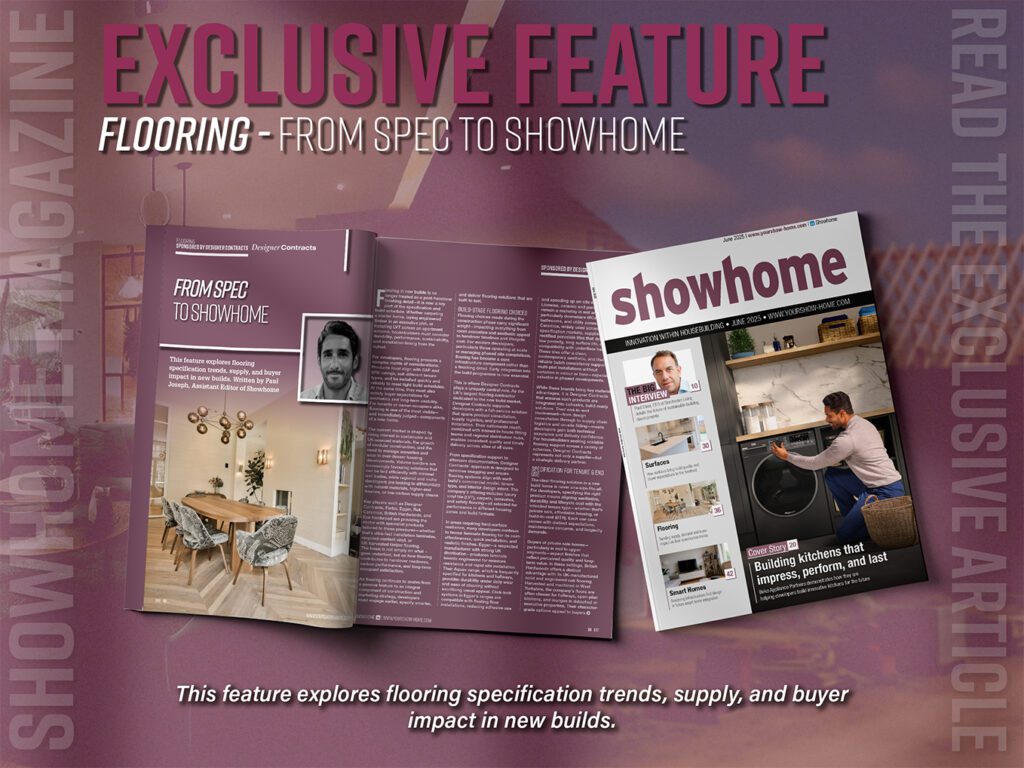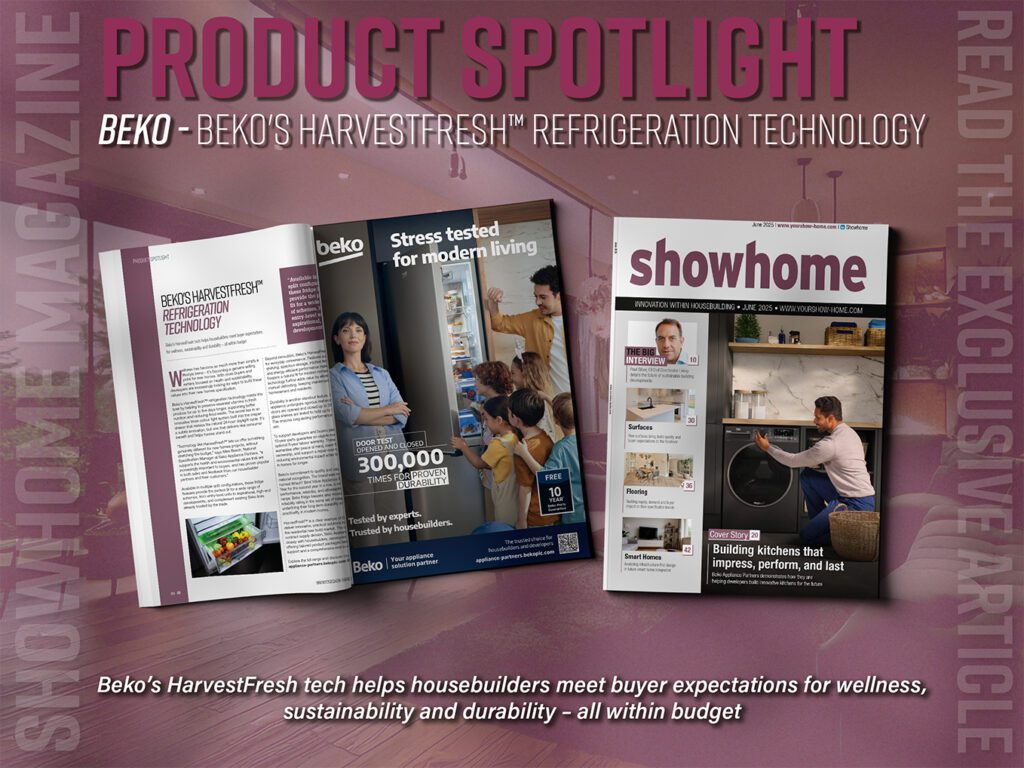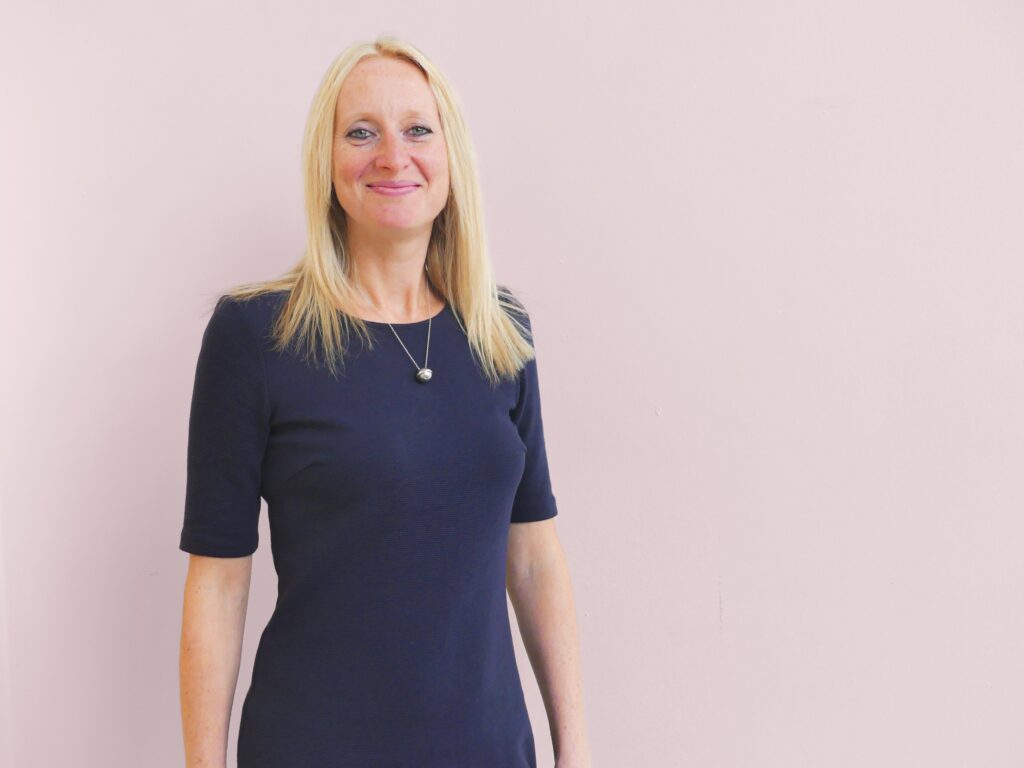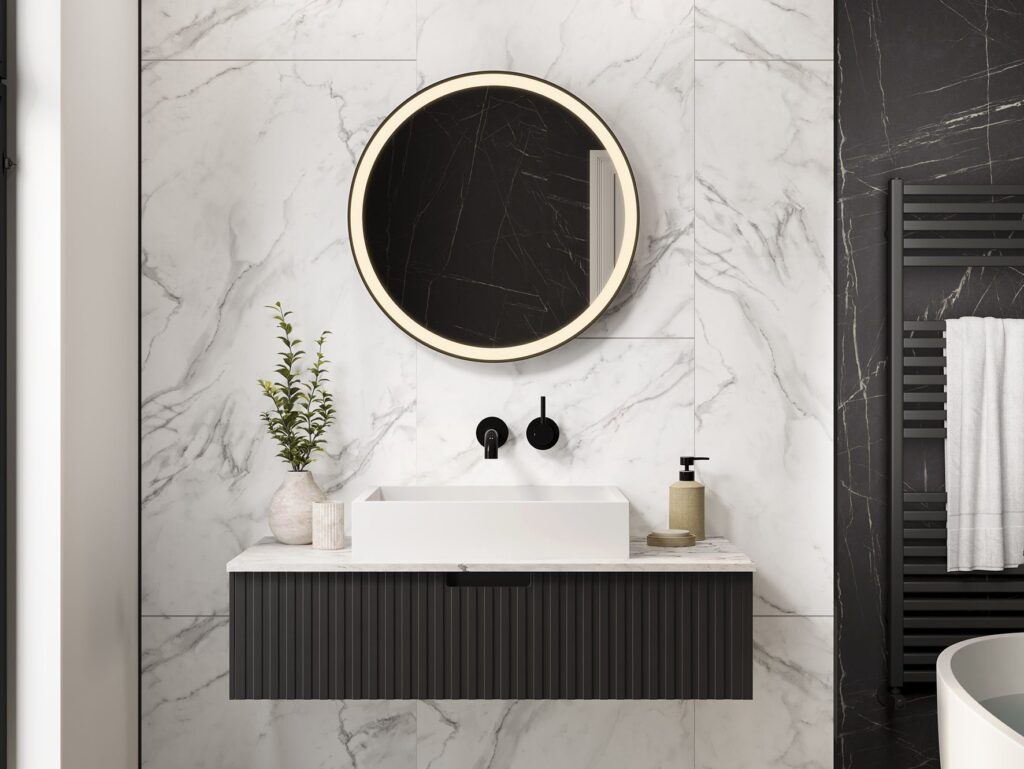Smart technology is becoming prevalent around the entire home, with bathrooms now also integrating intelligent, efficient systems, Showhome Editor Joseph Clarke observes
In residential construction and design, innovation remains a pivotal element for driving market competitiveness and enhancing client satisfaction. As such, the introduction of sophisticated technologies into home design has marked a transformative era, and this evolution is highly apparent in the modern bathroom. In fact, the integration of smart technology in bathroom designs stands out as a burgeoning trend poised to redefine the standards of luxury, comfort and functionality in homes across the UK.
The smart bathroom trend aligns seamlessly with the ongoing revolution in home automation, which already includes advancements in smart kitchens, intelligent living rooms, and even automated bedroom environments. This holistic approach to home technology integration speaks volumes about the future direction of residential living, where every aspect of the home is enhanced to foster a more convenient, comfortable and energy-efficient lifestyle.
The growing demand for smart bathrooms
In order to gain a better understanding of why we are witnessing such a rapid increase in the demand for smart tech in the bathroom, I spoke with Mark Dekkers, Leader, Residential UK, LIXIL EMENA & GROHE UK. Mark explained that “modern changes to our lifestyles have seen the bathroom evolve beyond merely a functional space in recent years. Core societal trends, such as a growing emphasis on health and wellness, personalisation, and sustainability, continue to seep into product design and innovation as consumers demand more convenience from their bathrooms than ever before.”
Upon further discussion, Mark highlighted that advancements in technology have made smart features more accessible and affordable, appealing to consumers seeking convenience and efficiency which has led to a more widely adopted transition of the connected market into our homes. Through this and the increasing rise of multi-generational households, there is an increased pressure on the products around us to perform well and, in many cases, do more than what we expected from them previously.
“The desire for sustainable living has also encouraged the adoption of water-saving and energy-efficient smart fixtures, as we become increasingly more aware of the impact we are having on the planet. Sustainability is therefore playing an increasingly bigger role in consumer purchasing trends as consumers are actively seeking out products that can support them in reducing water consumption and improving water and energy efficiency to live more sustainably,” he added.
Similarly, consumers are increasingly eager to track information about their daily activities, which is fuelling the demand for smart, connected home products and fixtures. These devices provide insights into consumption, usage and habits in ways that traditional items cannot. As this trend grows, such technologies are extending beyond kitchens and are becoming more and more common in bathrooms.
Tom Edmunds, Heating Expert & General Manager at Wunda Group, is also fully aware of the demand for intelligent bathroom systems, as consumers are keen to find ways to efficiently manage their energy consumption. According to Edmunds, “the surge in demand for smart bathrooms isn’t just a trend; it’s a necessity. People are increasingly turning to smart technology not just as a luxury but as a practical way to manage energy use and improve their quality of life. Smart devices, from simple thermostats to comprehensive energy management systems, are gaining popularity due to their affordability and effectiveness in reducing costs and environmental impact.”
Smart toilets
Smart shower toilets are beginning to be better understood by the mass market and the nation is starting to realise the true value of the benefits they can offer. Cleaning with water after using the toilet is an age-old tradition that is still favoured in many parts of the world. However, shower toilets bring this natural form of cleansing into the 21st century, using automation, app connectivity and personalisation.
“A personalised cleansing experience is made possible via a smartphone app on shower toilets such as GROHE’s Sensia Arena. Users can select their preferred temperature, spray pattern, pressure and much more, and even save their preferred settings as a profile, which can be remembered and used on any GROHE Sensia Arena toilet in the world. Automation and app functionality work hand in hand in the shower toilet sector and enable a completely touch-free toilet experience, from automatic flush and lid opening and closing to app-controlled washing and drying features. This not only promotes optimised personal hygiene but also eliminates the need to touch surfaces in the bathroom that may harbour germs and bacteria.” Explained Mark Dekkers, Leader, Residential UK, LIXIL EMENA & GROHE UK.
Smart showers
Dekkers also highlighted the fact that smart technology has made its way to the shower set up, and there are significant resource-savings to be made by opting for water-saving bathroom products. With more and more advanced technology being developed, many of these economical options are still able to deliver an excellent experience. Products such as the GROHE SmartConnect showerhead offer Bluetooth compatibility. “This means the shower can connect to a remote control placed within the shower enclosure, or outside of it, and switch between three different spray types, offering users ultimate convenience and going a long way in helping to create a luxurious, spa-inspired experience.” Said Dekkers.
I learned from our conversation that GROHE also recently introduced the GROHE Everstream concept, a revolutionary water-recycling shower concept. In summer 2024, GROHE Everstream will be introduced to the market as an exclusive launch for selected partners. GROHE Everstream has been designed to create the showering experience users expect but consuming as little fresh water as possible – and using far less energy. The Everstream system uses as little as a quarter of the water and a third of the energy typically required by traditional showers. In addition, GROHE is also aiming to have all GROHE concealed showers water-recycling-ready by 2030.
Smart taps
Infra-red capable products are enhancing accessibility for all household members, including the young and those with health or mobility issues, by providing easy-to-use functionality that boosts their independence and overall wellness. There’s a growing demand for infra-red enabled devices like WC actuators and taps, traditionally found in public spaces, now making their way into residential and luxury settings. The use of infra-red sensors allows for hands-free operation, minimising the need for direct contact with surfaces, which helps maintain cleanliness and reduce the spread of germs. This feature is particularly valuable in less frequently used bathrooms, such as ensuites or cloakrooms, contributing to a cleaner and more hygienic environment.
To give an example, the GROHE Plus tap with LED display comes with a chic acrylic-screen which hosts a LED temperature display, resulting in considered consumption with warm water often running unnecessarily. The tap further supports reduced water consumption thanks to its Spray function which allows the user to easily switch between a sustainable standard spray of 5.7l/min and an even greener water-saving flow of 4l/min by just a wave of a hand over the lit icon.
Smart heating
While there’s a growing array of dedicated smart bathroom products revolutionising our daily routines, it’s important to note that the evolution of smart home technology extends beyond the bathroom walls.
“Smart heating systems play a significant role in enhancing the overall comfort and efficiency of our homes, including the bathroom space. With consumers prioritising convenience, comfort, and energy savings, integrating smart thermostats capable of zoning across the entire home has become a popular choice. So, in addition to innovative bathroom-specific gadgets, the integration of smart heating systems contributes significantly to elevating the modern bathroom experience.” Revealed Tom Edmunds, Heating Expert & General Manager at Wunda Group.
By extending smart features like zone-specific temperature control to the bathroom, these systems make it possible to create a tailored environment that suits every need. As we continue to witness the convergence of technology and domestic spaces, the boundaries of what makes a home truly ‘smart’ are being redefined, promising an era of unparalleled convenience and sustainability.
“Combining underfloor heating with smart controls not only enhances comfort but also saves energy and money. With features like smart zoning, homeowners can customise heating settings to suit their needs while reducing wastage. The real-time data provided by smart devices empowers users to monitor and manage their energy consumption efficiently, leading to tangible savings on bills,” Edmunds concluded.
The competitive edge for housebuilders
Integrating smart technology into projects can provide a number of benefits, from appealing to the end-user, with improved convenience and modern fittings while also improving a building’s energy rating and catering to demand for more sustainable and efficient builds.
Experts like Edmunds and Dekkers acknowledge the significant benefits and broad appeal of integrating smart technology within the home. As consumers become more accustomed to automation and digital tracking in their daily activities, the demands of modern life lead many to seek enhancements in wellness through improved convenience and functionality offered by smart tech.
Furthermore, incorporating digital products in the bathroom helps housebuilders reduce their environmental footprint by using smart fittings that lead to more efficient water and energy consumption. Particularly with rising living costs and increased societal consciousness about water and energy use, there is a growing demand for smart fittings that enhance efficiency for both end-users and housebuilders.
Edmunds provided further clarification, stating that with the increasing demand for smart homes among consumers, integrating these technologies not only meets but exceeds expectations, positioning new builds as innovative and forward-thinking options.
“By incorporating energy-efficient solutions into the design, housebuilders can attract environmentally conscious buyers who are seeking sustainable living options. Moreover, the convenience and comfort provided by smart bathroom features add tangible value to new builds, appealing to a wide range of potential buyers. This integration not only sets new builds apart from traditional homes but also future proofs them against evolving consumer preferences and regulatory standards, ensuring long-term market competitiveness,” he advised.
Possible challenges
Integrating smart technology into a traditionally analogue space like the bathroom presents unique challenges, as accessibility, technology, usability and functionality must all be carefully balanced. A primary concern is ensuring that these smart fittings can seamlessly integrate into a variety of residential designs and meet enhanced performance expectations. As smart home technology proliferates, maintaining compatibility with other products and platforms emerges as both a challenge and a critical factor. Designers often lean towards industry standards or widely accepted ecosystems such as Bluetooth for its ease of function and broad familiarity.
Additionally, the issue of ensuring a reliable power source within the bathroom must be addressed. Designers must weigh the options of hardwiring, battery operations, or wireless charging, while ensuring convenience and safety are not compromised.
Moreover, given that bathrooms are naturally moist environments, it is crucial that smart devices are designed to resist moisture and direct water exposure. This involves choosing appropriate materials and employing sealing techniques that safeguard against humidity and splashing.
What’s next?
Looking ahead, the future development of smart bathrooms is poised for remarkable advancements. “As technology continues to evolve,” explained Edmunds, “smart bathroom systems are expected to become even more intuitive and energy efficient. Artificial intelligence and machine learning algorithms will likely play a significant role in optimising energy usage and personalising user experiences, making smart bathrooms even more tailored to individual preferences.”
Beyond energy management, smart bathrooms may incorporate features focused on water conservation and health monitoring, enhancing both sustainability and well-being. Additionally, interoperability among different smart home devices will become increasingly important, allowing for seamless integration and holistic automation systems within homes. “These developments not only enhance the functionality and efficiency of smart bathrooms but also contribute to the overall evolution of smart home ecosystems, shaping the future of residential living,” Edmunds added.
Echoing Edmunds observations, Dekkers concluded:
“With increased demand and technological advancements, smart bathrooms will likely integrate more seamlessly into daily life, offering enhanced features like personalised health monitoring, and further developments in water conservation, and energy efficiency. As innovation drives costs down, widespread adoption of these smart solutions could become the norm, reshaping the way we experience our daily routines.”
Read more news and exclusive features in our latest issue here.
Never miss a story… Follow us on:
Showhome
@Your_Show_Home
@Showhomemag
Media Contact
Joseph Clarke
Editor, Showhome
Tel: +44 (0) 1622 823 920
Email: [email protected]











